Haiti’s Peasants Fight Land Grab of Offshore Islands for Ecotourism | Les paysans d’Haïti luttent contre l’usurpation des îles du pays pour l’écotourisme
One-Week Ultimatum to Haitian Government From Ile-à-Vache Residents
By Staff (jep kft rc)
AlterPresse
English | French
Translated from the French by Dady Chery for Haiti Chery
Port-au-Prince, January 7, 2014. Residents of Ile à Vache (offshore island, southern Haiti) launched a one-week ultimatum on Monday, January 6, 2014, to Laurent Salvador Lamothe’s administration to give up its plans for “tourist destination, Ile à Vache,” learned AlterPresse.
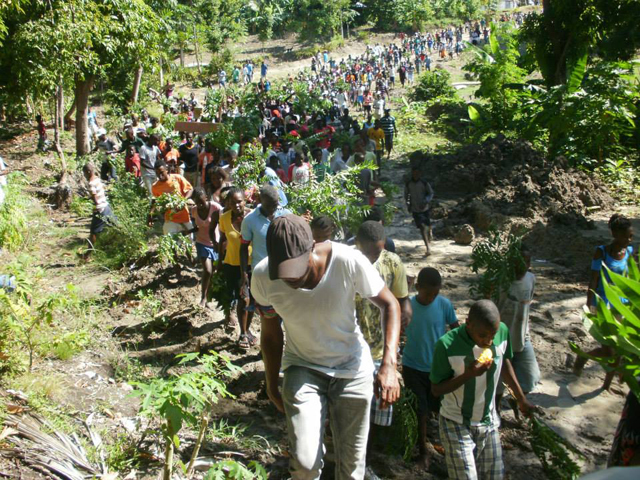 “If the government does not announce within a week (January 14, 2014 at the latest) the withdrawal of the project regarding Ile à Vache, we will begin a new phase in our engagement,” one of the protesters asserted to AlterPresse.
“If the government does not announce within a week (January 14, 2014 at the latest) the withdrawal of the project regarding Ile à Vache, we will begin a new phase in our engagement,” one of the protesters asserted to AlterPresse.
He would not specify what form the new phase of mobilization would take against the proposed project on Ile à Vache.
He reports that anonymous phone calls and death threats have been received by the movement’s leaders.
The Departmental Unit for the Maintenance of Order (UDMO) had planned to arrest demonstrators during the last protest on the island, but the impassable roads discouraged UDMO, said a protester to AlterPresse.
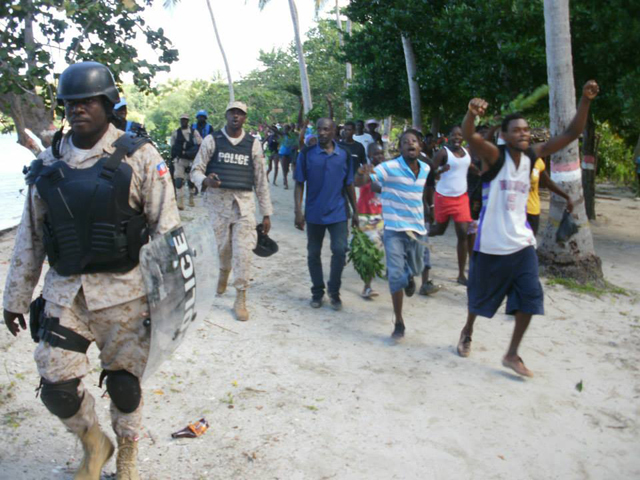 Possible expulsion from their land, to make way for a project of “modernization” of the island, explains the discontent of the people of Ile à Vache, who expressed their anger especially on Fridays December 27, 2013 and January 3, 2014.
Possible expulsion from their land, to make way for a project of “modernization” of the island, explains the discontent of the people of Ile à Vache, who expressed their anger especially on Fridays December 27, 2013 and January 3, 2014.
A few days after the most recent demonstration, the municipal council of Ile à Vache banned any form of protest on the island.
Ile à Vache: tourist destination and bone of contention
The tourist-destination project, launched on August 20, 2013, includes the construction of an international airport with a 2.6-kilometer [1.6-mile] runway, the construction of a road to this airport; dredging of a port; electrification and lighting of the surrounding area; construction of several resort hotels (1,000 rooms), 2,500 villas, a community center, a community radio station, an emergency center, and agricultural infrastructure.
The cost is more than $230 million ($ 1.00 = 45.00 gourdes, 1 euro = 64.00 gourdes).
To achieve this, the government intends to relocate inhabitants of coastal areas, especially from the fishing village Kay Kok (Roosters’ Place) and Madame Bernard, which are near to the luxury hotel Port Morgan.
 In May 2012, a presidential decree declared Ile à Vache and the country’s other offshore islands to be “tourism-development areas.”
In May 2012, a presidential decree declared Ile à Vache and the country’s other offshore islands to be “tourism-development areas.”
In this decree, particularly in Article 2, the presidency declared all properties and lands in these areas that had been the subject of leases or transactions between individuals retroactively for five years as being “state assets.”
This means that the Haitian government has unilaterally annulled legal property rights that had resulted from either sales, leases, or bequests from individuals.
“Many lands have been surveyed on the island without the consent of the owners. They target areas by the sea. The word is that the authorities will not take years, but months, to achieve their ends,” a resident of the island told AlterPresse.
In a statement released in December 2013, the tourism ministry tried to reassure the population by stating that nobody had to date been expelled from their land.
This seemed insufficient to calm the people, who are now in an uproar.
 “To take these lands will require that they kill all of us on the island,” said a Kay Kok villager, whose house is near to Port Morgan.
“To take these lands will require that they kill all of us on the island,” said a Kay Kok villager, whose house is near to Port Morgan.
According to one of the movement’s leaders, several plantations were destroyed as part of road infrastructure work that has gone nowhere. The project was meant to allow the construction of 15 kilometers [9.3 miles] of road.
Farewell to the dreams of entire families?
A few meters from the luxurious Port Morgan, surrounded by greenery, facing a white-sand beach and turquoise sea, is the small village of Kay Kok, home to a few hundred fishermen, noted AlterPresse.
Children come and go in search of mangoes to stoke their hunger, while foreign tourists, who have come to enjoy the unbeatable backdrop of the island, mingle with them.
The cost of living has changed on Ile à Vache since tourists, more and more, do not hesitate to pay in foreign currency, according to several witnesses.
Land on the island is worth gold today: a situation that outrages citizens of the area.
“Even our bones will not leave Ile à Vache. The displacement of the population will have a negative impact on people who depend on fishing, agriculture and livestock,” warns one of the leaders of the movement.
For him, to declare the area a zone of public utility, the government should have built a hospital, a university for the inhabitants and residents of the area, instead of despoiling the environment of Ile à Vache and clearing the peasants from their lands.
UPDATES
UPDATE #1: Monday, January 20, 2014 (AlterPresse). Roads were blocked, and businesses and schools were paralyzed, although the Minister of Tourism had given a 90-minute presentation to a group of farmers and met with them on January 16. “Ile à Vache is not for sale, not in bulk or in retail!” chanted the residents, who qualified the Minister’s presentation as a mere slide show and protested that they were denied the detailed plans for the island.
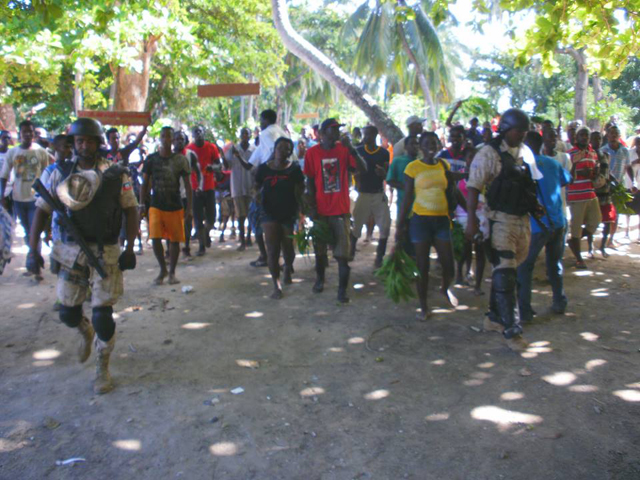 UPDATE #2: Tuesday, February 11, 2014 (AlterPresse). Members of the Organization of Ile à Vache Farmers (Konbit òganizasyon peyizan Ilavach, KOPI), who had organized the protests against tourism, reported that during the night of Sunday February 9, a group of national police (UDMO) arrived in the region. The police beat up residents Lethe Feguens, Charles Laguerre, Bertin Joseph Similien, and Maxo Bell, and forced them to remove the barricades they had erected for their protest; the following day, they beat up a young woman, Rosena Macena, for walking in the area of Madame Bernard. The farmer-organizers say they are being driven out of the region from fear for their lives.
UPDATE #2: Tuesday, February 11, 2014 (AlterPresse). Members of the Organization of Ile à Vache Farmers (Konbit òganizasyon peyizan Ilavach, KOPI), who had organized the protests against tourism, reported that during the night of Sunday February 9, a group of national police (UDMO) arrived in the region. The police beat up residents Lethe Feguens, Charles Laguerre, Bertin Joseph Similien, and Maxo Bell, and forced them to remove the barricades they had erected for their protest; the following day, they beat up a young woman, Rosena Macena, for walking in the area of Madame Bernard. The farmer-organizers say they are being driven out of the region from fear for their lives.
UPDATE #3: Wednesday, February 12, 2014 (AHP). The 20,000 or so Ile à Vache residents continue to protest against the appropriation of the entire island as a “zone of public utility,” including lands to which they hold the titles. Several companies have stopped their tourism-development projects and left the island. Mr. Jean David Geneste, the former Representative of the region to Haiti’s Parliament, worries that some of the protesters might get killed if nothing is done to improve the situation.
UPDATE #4: Friday, February 14 [Radyo VKM (Vwa Klodi Mizo)] Interview in Kreyòl with one of KOPI’s (Konbit òganizasyon peyizan Ilavach) organizers. He reports (first 15 min of the broadcast) that the residents of Ile à Vache do not recognize the government decree that divests them of their lands. Police are circulating on the island with major weapons. Several KOPI members have been beaten. He calls on all of the island’s landholders to keep calm despite the provocation, stay put and not allow the government to take over their properties. Simultaneously, he calls on people outside of Ile à Vache, in other Haitian cities and the Haitian diaspora, to support the struggle of those on the island.
UPDATE #5: Saturday, February 22, 2014 (AlterPresse) More than 40 paramilitaries from the Motorized Intervention Brigade (BIM) arrived on Ile a Vache on Thursday, February 20, destroyed several houses. On Friday, KOPI Vice President, Jean Matulnès Lamy, was arrested. Matulnès was imprisoned without ever seeing a judge. Many KOPI (Konbit peyizan Ilavach) members have gone into hiding. Later on Friday, Ile à Vache residents, brandishing tree branches and singing rara songs, protested in Kay Kok to demand Matulnès’ release and oppose a government delegation’s inauguration of a new community center, restaurant and radio station. The island’s residents complained that their needs for a high school and vocational school have been ignored. They reported that local masons, foremen and technicians were rejected for the construction work in favor of people from out of town. They noted that foreign financiers want different pieces of the island for projects that will negatively impact agriculture. The residents expressed grave doubts that tourism would improve their living conditions and questioned the bio-sustainability of razing the island’s only forest to build an airport for ecotourism.
KOPI President Marc Donald Lainé (nicknamed Jinal) said that KOPI still wants a recall of the May 10, 2013 decree that declared the entire island a zone of public utility. According to Jinal: “This is a lousy decree. This project reflects a macabre plan, a rat trap, a collective suicide, that aims to drive all the residents from the island. It is a cultural genocide that puts everyone in the island’s storm and dispossesses people of their lands. No one has the right to build on the island any more. If Ile à Vache is a hidden treasure, its people should enjoy it and get integrated into the proposed developments. We are craftsmen who have worked to beautify this corner of paradise that is so coveted by Lamothe’s administration.”
Listen to Jinal’s interview (in Kreyòl) with Radyo VKM below:
UPDATE #6: Monday February 24, 2014 (Radyo VKM). Seventeen Haitian organizations signed a communique that demands the release of KOPI Vice President, Jean Matulnès Lamy, and pledges solidarity with the Ile à Vache residents. “We, the signatory organizations bring our solidarity to the struggle of the people of Ile a Vache to stop the island from being turned into a zone for tourism, and we denounce the arrest and imprisonment [without trial] of Jean Matulnès Lamy for having supported the mobilization of the people of the island. We denounce the attacks and other arrests by police to intimidate the population. We believe that these actions against the Ile a Vache population fit in with the logic of macoute power, at the service of the international, that does not respect the principle of the right to self preservation, which is a fundamental democratic principle.”
UPDATE #7: Tuesday, February 25, 2014. About 12 people were injured and two were arrested during a peaceful demonstration of about 1,000 Ile à Vache residents near the area of Madame Bernard during the morning of Tuesday February 25. The injured included Adrien Justin and Genel Justin, and the arrests were of Carl Oza and Aizan Silien. Although it was raining, the demonstration started spontaneously when the island’s residents learned that Konbit peyizan Ilavach (KOPI) Vice President Jean Matulnès Lamy was taken to court but was not heard by a judge and instead dragged to the national penitentiary.
Multiple eyewitnesses report that policemen from the Motorized Intervention Brigade (BIM) arrived in the area with the local interim governor, Fritz Cesar, who carried a 9-mm handgun and pointed out which protestors should be beaten or arrested. The police fired live ammunition to break up the protest. KOPI members, who say they were singled out, are being called “bandits” and accused of poisoning people’s minds, have gone underground.
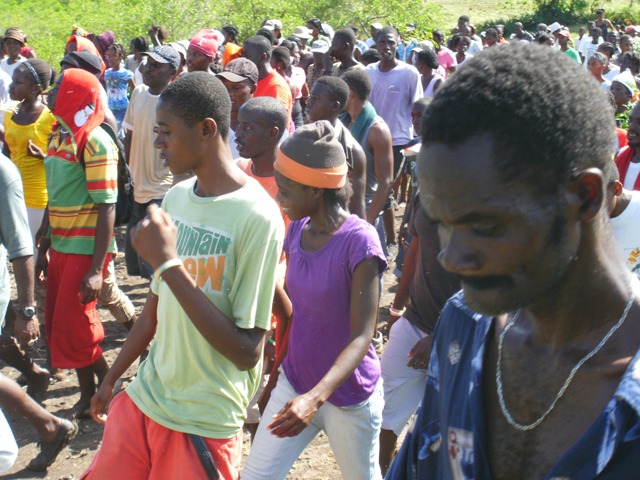 One resident recalled that Ile à Vache was a peaceful place, with only two policemen, until it caught the eye of the government and foreign investors. Children have stayed at home since Thursday February 20, when heavily armed men invaded their schools. Several residents noted that no government representative* has stepped up to help them, although there is talk of elections and solicitation of their votes. One KOPI member questioned whether the development of hotels and golf courses — instead of municipal water, roads, and electricity — is intended to benefit the island’s residents.
One resident recalled that Ile à Vache was a peaceful place, with only two policemen, until it caught the eye of the government and foreign investors. Children have stayed at home since Thursday February 20, when heavily armed men invaded their schools. Several residents noted that no government representative* has stepped up to help them, although there is talk of elections and solicitation of their votes. One KOPI member questioned whether the development of hotels and golf courses — instead of municipal water, roads, and electricity — is intended to benefit the island’s residents.
The residents are resolute in their protest and say: “We will not keep quiet. We will not give up.” Some say they are prepared to die. They remind the people of the nearby city of Aux Cayes that Ile a Vache has helped them to stay alive with fresh fish and vegetables. They call on Haitians everywhere for their support and caution them to remember the proverb: “When chicken passes by and sees turkey being feathered, chicken should check if it is wet.”
______________________________________________
*On Thursday, February 27, 2014, Senate Committee for Justice and Security Chairman, Pierre Francky Exius, announced that he will call on Justice Minister Jean-Renel Sanon and the Chief of Police to discuss the Ile à Vache situation. Senator Exius qualified the arrest of Mr. Jean Matulnès Lamy as being politically motivated.
Listen to interviews with Radyo VKM (in Kreyòl):
UPDATE #8: Wednesday, March 5, 2014 (Radyo VKM). Members of the Organization of Ile a Vache Farmers (KOPI) — still underground and hunted by paramilitaries — did not meet with Tourism Minister Stephanie Villedrouin when she came to Ile a Vache on Saturday March 1, ostensibly for an audience with the islanders. Mrs. Villedrouin should have been accompanied by the Prime Minister, but Mr. Lamothe did not show up. The islanders, including the KOPI members, say they will not meet with government representatives until after:
- 1. The May 10, 2012 decree to appropriate their lands is repealed.
- 2. The 100 Motorized Intervention Brigade (BIM) paramilitaries are removed from the island.
- 3. Local policeman and activist Jean Matulnes Lamy is released.
- 4. A campaign of defamation on Haitian radio, which labels KOPI members as being bandits, is stopped.
Mrs. Lamy attended the meeting at which her husband’s imprisonment was tied to the islanders’ pacification. Specifically, Mrs. Villedrouin demanded that the residents behave “reasonably,” stop all street protests and bring her petitions instead.
The population remains an uproar about being displaced. They accuse the politicians of lying because 20 families have already been dispossessed, although they were promised that no one would be. They bemoan their lack of representation in the Haitian government and the corruption of their supposed representatives. They credit themselves with having forested for many generations the island that has become so coveted for a land grab.
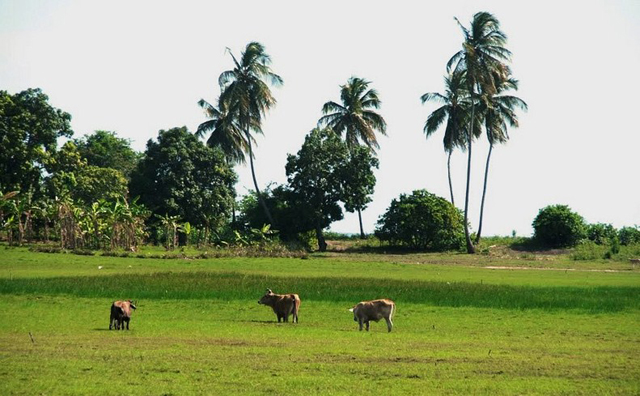 UPDATE #9: Tuesday, March 11, 2014. Ile a Vache is under siege. People abroad and on mainland Haiti need to show their support for the islanders by continuing their protests and insisting on the demands that they had made while they could still speak freely. These demands to the Martelly-Lamothe government are: (1) Repeal the decree to appropriate all Ile a Vache lands, (2) Withdraw the 100 militarized police that have been introduced on the island, (3) Release KOPI Vice President and local policeman Jean Matulnes Lamy from prison, and (4) Stop a campaign of defamation of their representatives in KOPI. The government has responded to none of these demands. Instead, on Monday March 10, Tourism Minister Stephanie Villedrouin gave a press conference at which she announced that 15 additional militarized police had been deployed “to stabilize the area.”
UPDATE #9: Tuesday, March 11, 2014. Ile a Vache is under siege. People abroad and on mainland Haiti need to show their support for the islanders by continuing their protests and insisting on the demands that they had made while they could still speak freely. These demands to the Martelly-Lamothe government are: (1) Repeal the decree to appropriate all Ile a Vache lands, (2) Withdraw the 100 militarized police that have been introduced on the island, (3) Release KOPI Vice President and local policeman Jean Matulnes Lamy from prison, and (4) Stop a campaign of defamation of their representatives in KOPI. The government has responded to none of these demands. Instead, on Monday March 10, Tourism Minister Stephanie Villedrouin gave a press conference at which she announced that 15 additional militarized police had been deployed “to stabilize the area.”
At the press conference, Mrs. Villedrouin insisted that no one has been displaced, although 20 families have already been dispossessed and not compensated. She suggested that not all the island will be developed for tourism while neglecting to mention that the tourism project would involve nine phases that will gradually appropriate the western half of the island, including all 20 beaches that fishermen had been using, plus the eastern part for an airport, the middle for an east-west road, and the north central area for a port.
Mrs. Villedrouin announced that residents of different areas of the island will be visited and asked to write their complaints to the government. Given that all the representatives of the residents have been muzzled, either by being imprisoned or driven underground, this latest move by the Haitian authorities suggests that a cynical and systematic campaign of intimidation and coercion is underway.
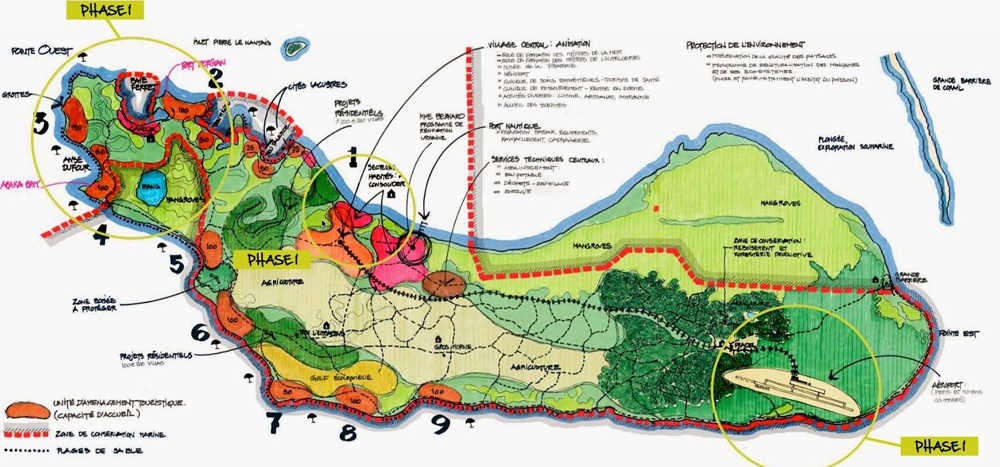 UPDATE #10: Monday, March 24, 2014 (AlterPresse). A follow up on the savage police beatings that took place on Ile a Vache on February 8-10 confirmed them. Rosena Macena reported: “They crushed me with kicks from their boots. I’ve been hemorrhaging ever since.” Lethe Feguens said: “They hit me so much in the face that my ear drum ruptured.” Several other people also reported that they had been beaten. When asked about these accusations, the police responded that they had escorted the local people.
UPDATE #10: Monday, March 24, 2014 (AlterPresse). A follow up on the savage police beatings that took place on Ile a Vache on February 8-10 confirmed them. Rosena Macena reported: “They crushed me with kicks from their boots. I’ve been hemorrhaging ever since.” Lethe Feguens said: “They hit me so much in the face that my ear drum ruptured.” Several other people also reported that they had been beaten. When asked about these accusations, the police responded that they had escorted the local people.
The farmers on Ile a Vache say they will persevere with their movement until their demands are met. They do not oppose the development of the island but strongly oppose the plans for luxury villas and golf courses. Furthermore, they want their fundamental needs to be met: one of these being a lack of schools beyond junior high school.
KOPI member Kenold Alexis noted: “This project is inconsistent with our basic needs, such as roads, clean drinking water, hospitals, electricity, schools for our children, vocational training centers, modernization of fishing and agriculture.” Organization of Women in Action on Ile a Vache (ORFAIV) member Alberonie Bell said: “We still have have no details of the project. We are prepared to approve it if they build schools, hospitals, roads, and systems to supply drinking water. As for building villas, hotels, and golf courses: we are totally opposed.” KOPI’s president stressed: “Ile a Vache is owned by the state and is therefore a commons that belongs to the entire population. The ongoing project seeks to privatize. People connected to the Martelly presidency and the Lamothe government hope to get a few perks that will let them play golf and swim with foreigners.”
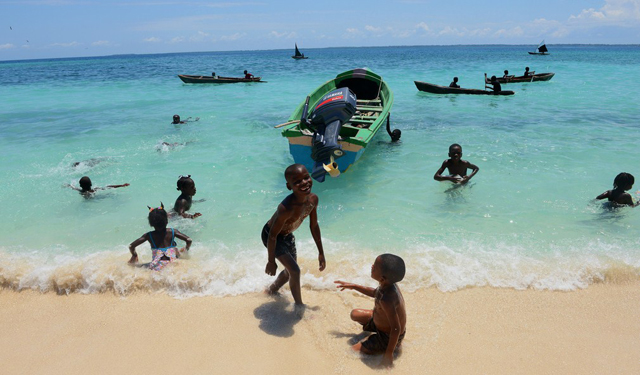 UPDATE #11: Friday, April 11, 2014. United States General and Southern Command (SouthCom) Commander John Kelly, together with US Ambassador to Haiti, Pamela White, and Haitian President Michel Martelly visited Ile a Vache for approximately two hours on the afternoon of Wednesday, April 9, 2014. The population got up early on the same day to block access to several areas, from Kay Kok to Bois Bouton, to protest against the decree to turn the island into a “zone for tourism development and public utility.” The visit by these three officials, who came by helicopter to the Abaka Bay and Port Morgan resorts, was ostensibly a side trip from the inauguration of a USAID project in Aux Cayes. On the other hand, a US four-star general and commander does not routinely spend hours abroad on casual visits. Is Ile a Vache being considered for a US base?
UPDATE #11: Friday, April 11, 2014. United States General and Southern Command (SouthCom) Commander John Kelly, together with US Ambassador to Haiti, Pamela White, and Haitian President Michel Martelly visited Ile a Vache for approximately two hours on the afternoon of Wednesday, April 9, 2014. The population got up early on the same day to block access to several areas, from Kay Kok to Bois Bouton, to protest against the decree to turn the island into a “zone for tourism development and public utility.” The visit by these three officials, who came by helicopter to the Abaka Bay and Port Morgan resorts, was ostensibly a side trip from the inauguration of a USAID project in Aux Cayes. On the other hand, a US four-star general and commander does not routinely spend hours abroad on casual visits. Is Ile a Vache being considered for a US base?
UPDATE #12: Wednesday, April 16, 2014 (Radyo VKM) The people of Ile a Vache took to the streets again on Wednesday, April 16, 2014, and blocked all construction for tourism. A major issue of their protests is the dissolution of local government by decree. Part of the May 10, 2013 decree states that local functions, such as regulation of Ile-a-Vache housing codes, now come under control of the Tourism Minister, in Port-au-Prince, instead of the local City Hall.
The protesters demand that the government: 1. Recalls the decree. 2. Unconditionally releases local policeman and Organization of Ile a Vache Farmers (KOPI) leader Jean Matulnes Lamy from prison. 3. Withdraws the Martelly-appointed Interim Governor Fritz Cesar and all militarized police.
The only incident was a scuffle between protesters and Henry Cesar (Fritz Cesar’s brother and security guard), who had followed Radyo VKM’s photographer for more than five minutes, snapping pictures of him.
The protesters say that they will not stop their actions until they are heard. A sit-in is planned for April 23, 2014 during a meeting of Haiti’s Southern Delegation. A press conference in Port-au-Prince is also on the agenda.
UPDATE #13. Saturday, October 25, 2014 (Radyo VKM). The President of Konbit Peyizan Ilavach (Organization of Ile a Vache Farmers, KOPI), Marc Donald Laine, nicknamed Jinal, died early Saturday, October 25, 2014 from injuries sustained in a traffic accident involving his motorcycle the previous evening around 10 p.m. After the arrest and incarceration of Jean Matulnes Lamy, Jinal was one of the people who bravely continued to lead KOPI, the main organization that opposes the regime’s development of the offshore island, Ile a Vache, into a tourism destination without any input from the residents. Several times, he noted on radio interviews that he had been offered inducements to leave Haiti (money, visas) and also received death threats. He had replied for the record, that not even his bones would ever leave Ile a Vache.
UPDATE #14. Friday, December 12, 2014 (Radyo VKM). Jean Matulnes Lamy, the Vice President of the Organization of Ile a Vache Farmers (Konbit Peyizan Ilavach, KOPI), who had been imprisoned since February 25, 2014, was released early this morning. In a telephone call to Radyo Vwa Klodi Mizo around 1 pm, he expressed his thanks to everybody who has helped him, to Radyo VMK, and to the people in Haiti’s Southern Department and especially those on Ile a Vache for their solidarity. About his dead comrade, former KOPI President Marc Donald Laine, he said: “Jinal is gone, but he serves as a serum to invigorate us so as to continue the struggle.” On the details of his release, he explained that he had been formally released on Monday, December 8, 2014 but was not allowed to go because Kerson Darius Charles had objected to his release, but on Friday morning, he was woken up with the good news. He especially thanked Senator Francky Exius of the Southern Department, MP Arnel Belizaire, and former Senator Gabriel Fortune for bringing pressure to bear on the government. When asked if he would keep his job as a policeman, he answered, “Yes, I will.” He promised to grant a longer interview to Radyo VKM at 7 pm.
Sources: Haiti Chery (English) | AlterPresse (French)
Haiti’s Tourism Plans for Ile à Vache
By Staff
Caribbean Journal
Haiti has revealed its plans for tourism development on the island of Ile à Vache.
The Ministry of Tourism is proposing the eventual development of 1,500 units on the 52-square-kilometer [20-square-mile] island, which is located off the southeast coast of Les Cayes, as part of an across-the-board tourism project.
“Ile a Vache is one of the last true treasure islands of the Caribbean,” the Ministry of Tourism said in its proposal. “Here, tourism is progressing slowly in a sustainable manner, building places of peace and well-being while helping local communities.”
The plan calls for laid-back, low-density eco-tourism-style development, highlighting areas like cultural heritage, agro-tourism and history, on an island with more than 20, mostly deserted beaches.
It will focus on sustainable tourism development, from a push for solar power to the use of electric shuttles instead of cars.
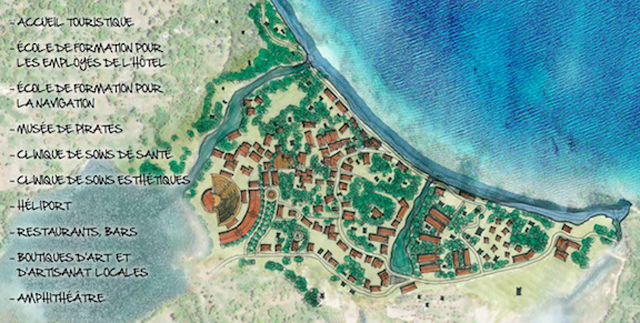 In the short term, the Ministry said it would begin presenting its master plan to potential investors in countries like the Dominican Republic, Qatar, China and the wider Caribbean, before beginning short-term investment in infrastructure.
In the short term, the Ministry said it would begin presenting its master plan to potential investors in countries like the Dominican Republic, Qatar, China and the wider Caribbean, before beginning short-term investment in infrastructure.
The first phase of the project would be the Anse Dufour near the village of Madame Bernard; that development would primarily feature bungalows and villas.
The overall plan would create the “Village of Mary Anne,” a touristic village with restaurants, cafes, galleries and markets.
It would additionally include an agro-tourism component, proposing the creation of a community farm managed by locals that would allow visitors to take part in agricultural activities.
The Ministry emphasized that it would be working to ensure sustainable development on Ile à Vache, in its agricultural development and conservation.
It said the government would be working to develop standards of environmental protection and planning for the island, particularly to protect sensitive areas like coastal mangroves and fish habitats.
Haiti said it would be targeting four major types of travelers for the area: explorers and adventure travelers, romance travelers, members of the Haitian diaspora and wellness travelers.
Haiti’s Prime Minister first mentioned the government’s interest in developing Ile à Vache in an interview with Caribbean Journal on December 6, 2012.
Source: Caribbean Journal
Excerpt from Haitian Prime Minister Laurent Lamothe’s interview with Caribbean Journal‘s Alexander Brittel, added by Haiti Chery:
Haiti’s Tourism Minister, Stephanie Villedrouin, has been pushing a new tourism strategy for Haiti. What do you see as the best ways to grow that sector in the country?
One of them is Ile a Vache, the second site where we have invested. We have invested already in Jacmel, over $40 million to refurbish the town of Jacmel in the southeast of the country to be a port for tourism and boats to come in for a few days and enjoy that port. And now, we have decided to take the tourism development on the island of Ile a Vache, so there we’re going to build an international airport, and then the tourism [infrastructure] to attract investors — we have several investors already. There is a hotel coming up there [in Ile a Vache], which is certainly one of the nicest islands in the Caribbean.
Can Haiti eventually produce a significant portion of its GDP from tourism, like many of its Caribbean neighbours?
This is the objective — this is the goal. We have — again — a treasure in the Caribbean that we can exploit and promote fully and invest in fully. I think Ile a Vache has great potential, and it doesn’t present the challenges for land title that you might face on the mainland.
Sources: Haiti Chery (English) | AlterPresse (French), Jan 7, 2014 | Caribbean Journal, Mar 7, 2013 | Caribbean Journal, Dec 6, 2012 | Protest photos from Radyo VKM added by Haiti Chery.
Haïti-Tourisme : Persistance du climat de méfiance à Île-à-Vache, où les travaux ont repris
Par Lafontaine Orvild
AlterPresse
anglais | français
Port-au-Prince, le 18 mars 2014 — Alors qu’une trêve – observée dans la mobilisation des paysans de l’Île-à-Vache contre le projet touristique gouvernemental – a été levée le vendredi 14 mars 2014, les travaux ont repris sur l’ile, apprend AlterPresse.
Le climat de méfiance persiste à Ile-à-Vache. Les paysannes et paysans continuent de dénoncer la répression, dont ils ont été l’objet, suite aux mouvements de protestation contre le projet gouvernemental baptisé « Destination touristique Île-à-Vache ».
Récemment, le gouvernement a annoncé des travaux d’arpentage pour fournir des documents tenant lieu de titres de propriété aux habitants.
Une centaine de familles risquent d’être relocalisées, selon le ministère du tourisme.
Refus de céder les terres
Dix mois après l’arrêté présidentiel, déclarant Île-à-vache zone réservée et de développement touristique, des paysans attachés à leurs parcelles craignent les répercussions qu’aura ce projet touristique sur l’agriculture, l’élevage et la pêche.
« Ce projet semble ne pas cadrer avec nos besoins fondamentaux, tels que : routes, eau potable, hôpitaux, électricité, écoles pour nos enfants, centres de formation professionnelle, modernisation de la pêche et de l’agriculture », fustige Kenold Alexis, conseiller de Konbit peyizan Ilavach (Kopi).
Le projet, de faire de l’Île-à-vache un important pôle de développement touristique et économique – susceptible d’attirer des flux de touristes locaux et étrangers -, remonte à mai 2012.
Dans une interview accordée au « Carribean Journal », le premier ministre Laurent Salvador Lamothe a promis que, le terrain étant déblayé, les défis de titres fonciers ne se posaient pas.
L’Île-à-vache, île de 55 kilomètres carrés au Sud d’Haïti, a été promise à des investisseurs du Qatar, de la République Dominicaine, de la Chine, de la région des Caraïbes, du Royaume-Uni et des États-Unis d’Amérique, comme étant un joyau des Caraïbes et un potentiel dessiné pour les écotouristes.
L’initiative du président Joseph Michel Martelly et du gouvernement Lamothe n’est, cependant, pas la bienvenue chez la grande majorité des agricultrices et agriculteurs, au point qu’ils déclarent « irrecevable » l’arrêté du 10 mai 2013.
Déclarant l’ensemble de l’île « une zone d’utilité publique », cet arrêté aurait pour objectif de les dépouiller de leurs terres, craignent-ils.
« Les terres de l’Île-à-vache sont propriété de l’État, donc de l’ensemble de la population. Le projet en cours tend à la privatiser. Les proches de la présidence Martelly et du gouvernement Lamothe espèrent bénéficier de quelques miettes qui leur permettraient de jouer au golf et de se baigner avec les “blancs” », soutient, avec véhémence, un étudiant en sciences juridiques et président de Konbit peyizan ilavach (Kopi).
Pour un projet touristique intégré
La population précise qu’elle n’est pas totalement opposée « au projet en soi », mais, plutôt, à la forme adoptée par les autorités qui « font usage de la force à la place du dialogue ».
« Jusqu’à présent, nous n’avons aucune information précise du projet. Si [les autorités de l’État] construisent des écoles, hôpitaux, routes, systèmes d’adduction d’eau potable, nous serons prêts à donner notre accord au projet. Mais, pour l’édification de villas, d’hôtels, de terrains de golf, nous sommes totalement opposés », déclare Albéronie Bell, 50 ans, mère de huit (8) enfants, membre d’une petite coopérative d’aide aux femmes, coiffée par l’’Organisation des femmes en action de l’Ile-à-vache (Orfaiv).
Protestataires brutalisés
Après avoir scandé que « l’île n’est pas à vendre », les résidentes et résidents se disent scandalisés par la violence, orchestrée par le gouvernement sur l’île, où, traditionnellement, deux policiers nationaux étaient en service.
« Un projet, qui vise le développement de l’île, ne saurait être imposé par la répression et l’intimidation de la population », dit Altersena Douyon, enseignante et secrétaire de l’Orfaiv.
Plusieurs opposants au projet avouent qu’ils sont bastonnés et matraqués par des agents de la Brigade d’intervention motorisée (Bim) pour avoir protesté contre le projet touristique de l’Île-à-Vache.
Dans la soirée du dimanche 9 au lundi 10 février 2014, la police nationale a malmené , Rosena Macéna (une jeune femme de trente ans), Lethé Feguens, Charles Laguerre, Bertin Joseph Similien, Maxo Bell, et les ont forcés à enlever les barricades qu’ils avaient érigées pour barrer la route à la brigade.
« Ils m’ont écrasée à coup de bottes. Depuis lors, j’ai de l’hémorragie », soupire Rosena Macéna.
« Ils m’ont tellement frappé en plein visage que mon tympan s’est fracturé », confie Feguens, 27 ans.
Interrogés à « Kay Kòk », par AlterPresse, sur les accusations portées contre eux par les victimes, les policiers nationaux affirment ne pas avoir réprimé les manifestants, mais les avoir accompagnés.
Le Réseau national de défense des droits humains (Rnddh) et la Plateforme des organisations haïtiennes de droits humains (Pohdh) ont diligenté une enquête en vue d’éclaircir ce dossier.
Pour leur part, les paysannes et paysans entendent poursuivre leur mouvement, tant que leurs revendications ne sont pas satisfaites.
Lors d’une présentation, le 10 janvier 2014 à l’Île-à-Vache, d’un diaporama montrant les zones qui seront affectées par le projet touristique, la titulaire du ministère du tourisme, Stéphanie Balmir Villedrouin, a reconnu qu’il faut l’aval de la population pour implémenter le projet, dont le coût est de plus de 230 millions de dollars américains (US $ 1.00 = 45.00 gourdes ; 1 euro = 65.00 gourdes aujourd’hui). [lo kft rc apr 18/03/2014 1:05]
Haïti-Tourisme : Ultimatum d’une semaine des habitants de l’Ile à Vache au gouvernement Lamothe
Par le personnel (jep kft rc)
AlterPresse
anglais | français
Port-au-Prince, 7 janvier, 2014. Des habitantes et habitants de l’Ile à Vache (Sud) lancent, ce lundi 6 janvier 2014, un ultimatum d’une semaine pour que le gouvernement de Laurent Salvador Lamothe renonce à son projet «Destination touristique Ile à Vache», apprend AlterPresse.
«Dans le cas où le gouvernement n’annonce pas, dans une semaine (le 14 janvier 2014 au plus tard), le retrait de son projet autour de l’Ile à Vache, nous entamerons une nouvelle phase dans notre mobilisation», affirme à AlterPresse l’un des protestataires.
Ce dernier n’a pas voulu préciser quelle forme prendra la nouvelle phase de mobilisation contre le projet envisagé sur l’Ile à Vache.
Il fait état de coups de fil anonymes et de menaces de mort, reçus par les chefs de file du mouvement.
L’Unité départementale de maintien d’ordre (UDMO) aurait même prévu d’appréhender des manifestants lors du dernier mouvement de protestation sur l’île. Mais l’impraticabilité des routes l’aurait dissuadée, rapporte le protestataire à AlterPresse.
La possible expulsion de leurs terres, que devrait entraîner le projet dit de modernisation de l’île, explique la grogne des habitants de l’Ile à Vache qui ont manifesté leur colère sur l’ile, notamment les vendredi 27 décembre 2013 et vendredi 3 janvier 2014.
Quelques jours après la plus récente manifestation, le conseil municipal à Ile à Vache aurait interdit toute forme de manifestation sur l’ile.
Ile à vache, destination touristique et pomme de discorde
Lancé le 20 août 2013, le projet prévoit la construction d’un aéroport international avec une piste de 2,6 kilomètres; la construction de l’axe routier qui y mène; le dragage du port, l’électrification et l’éclairage de toute la zone environnante; la construction de plusieurs hôtels-ressorts (1,000 chambres), de 2,500 villas; d’un centre communautaire; d’une radio communautaire; d’un centre d’urgence, ainsi que la mise en place d’infrastructures agricoles.
Le coût est de plus de 230 millions de dollars américains (US $ 1.00 = 45.00 gourdes ; 1 euro = 64.00 gourdes aujourd’hui).
Seulement pour y parvenir, le gouvernement entend délocaliser plusieurs habitantes et habitants des zones côtières, notamment du village pêcheur «Kay Kok» (en français «Cayes Coq») et Madame Bernard, limitrophe du luxueux hôtel Port Morgan.
En mai 2012, un arrêté présidentiel déclare «zones de développement touristique» l’Île-à-vache ainsi que d’autres îles du pays.
Dans ce même arrêté, plus particulièrement dans l’article 2, la présidence proclame «possessions de l’État» toutes les propriétés et terrains de ces zones, ayant fait l’objet de bail ou de transactions entre particuliers, et ce, rétroactivement, soit cinq (5) années auparavant.
Cela signifie que l’État haïtien annule, de façon unilatérale, tout droit de propriété légale, qui découlerait soit de la vente, soit de l’affermage, ou de legs entre particuliers.
«Plusieurs terrains ont été arpentés sur l’Ile, sans le consentement des propriétaires. Ils visent des espaces au bord de la mer. Selon les bruits qui courent, les autorités n’attendraient pas des années, mais plutôt des mois, pour parvenir à leurs fins», explique à AlterPresse un habitant de l’ile.
Dans un communiqué diffusé en décembre 2013, le ministère du tourisme s’est voulu rassurant en indiquant que personne n’a, à date, été expulsé de ses terres.
Cela semble insuffisant pour calmer les esprits, désormais à vif.
«Pour prendre ces terres, il faudra que l’on nous tue tous sur l’ile», réagit un habitant du village «Kay Kòk», dont la maison se trouve à proximité du Port Morgan.
Selon l’un des chefs de file du mouvement, plusieurs plantations ont été détruites dans le cadre de travaux d’infrastructures routières qui n’avancent, pourtant, pas. Le projet devrait permettre de construire 15 kilomètres de route.
Adieu le rêve de familles entières?
A quelques mètres du luxueux hôtel Port Morgan, niché dans la verdure, face à une plage de sable blanc et une mer turquoise, se situe un petit village, Kay Kòk, abri de quelques centaines de marins pêcheurs, observe AlterPresse.
Des enfants vont et viennent, à la recherche de mangues pour attiser leur faim, alors que les touristes étrangers – venus profiter du décor inimitable de l’ile – se mêlent à eux.
Le coût de la vie aurait changé sur l’Ile à Vache, depuis que les touristes, de plus en plus nombreux, n’hésitent pas à payer en monnaie étrangère, selon plusieurs témoignages.
Les terres sur l’île vaudraient de l’or, aujourd’hui.
Une situation, qui révolte les citoyennes et citoyens de la zone.
«Même nos ossements ne quitteront pas l’ile à Vache. Car, le déplacement de la population aura des conséquences négatives sur les gens qui vivent de la pêche, de l’agriculture et de l’élevage», prévient un des chefs de file du mouvement.
Pour lui, en déclarant la zone d’utilité publique, le gouvernement aurait pu construire un hôpital, une université pour les habitantes et habitants de la zone, au lieu de dénaturer l’environnement de l’Ile à Vache et de déguerpir les paysans de leurs terres.
Sources: AlterPresse (7 janvier 2014) | AlterPresse (18 mars 2014)

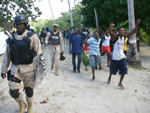
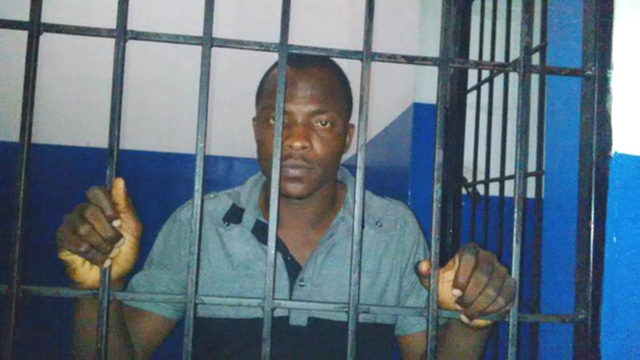
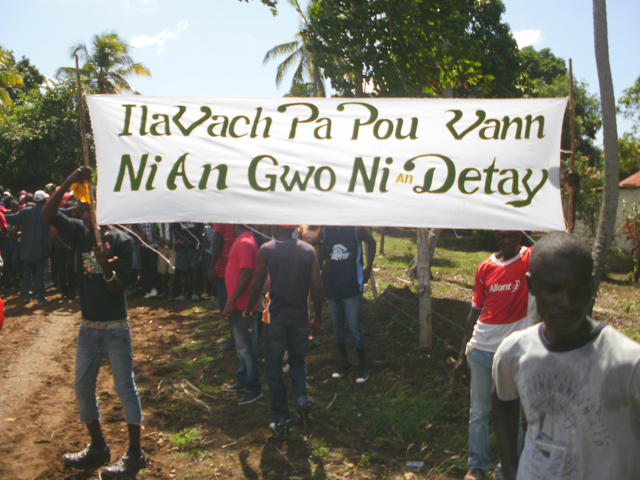
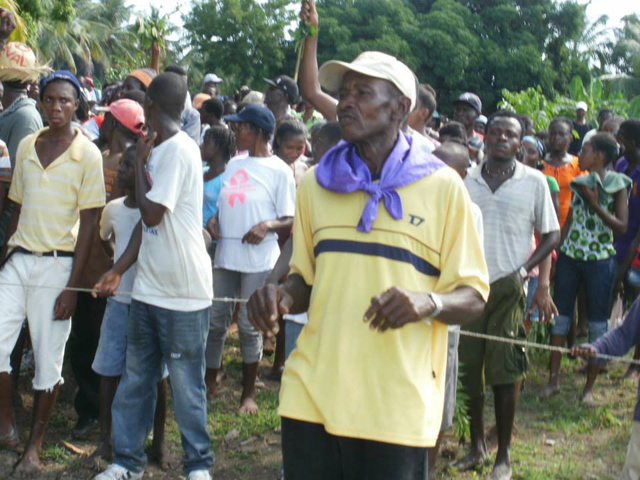
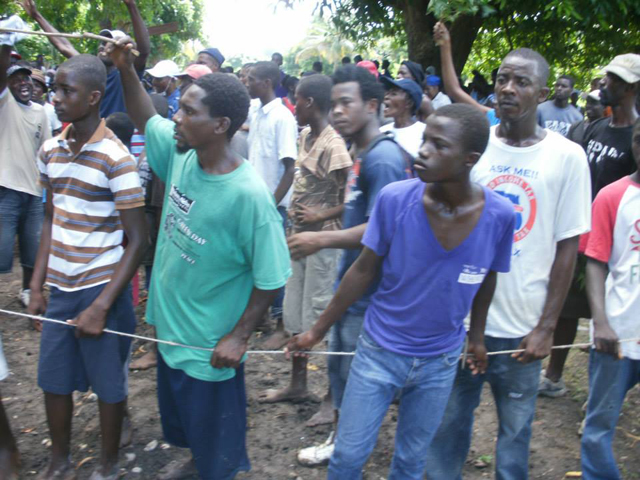
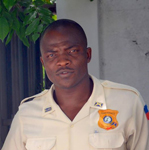
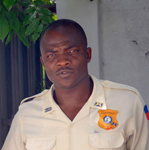
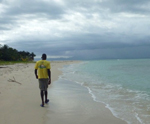



I don’t understand the greediness, the need to exploit and the need to be like others. Let Haiti be Haiti. This past earthquake has really messed things up.